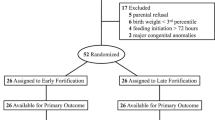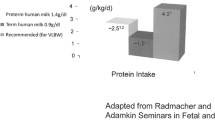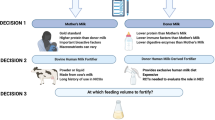Abstract
Objective:
To determine whether human milk fortification from the time of the first feeding significantly improves weight gain and bone mineral status in infants of <31 weeks estimated gestational age as compared with delayed or standard human milk fortification.
Study Design:
This was a retrospective pre–post design. In all, 95 infants born at <31 weeks estimated gestational age were compared. There were 53 infants in the early fortification group (EFG) and 42 infants in the delayed fortification group (DFG). They were compared with regard to weight gain at 34 weeks postmenstrual age (PMA), and their serum levels of calcium, phosphorus and alkaline phosphatase levels were compared as an indicator of bone mineral status. The practice change of fortifying all human milk given to preterm infants at <34 weeks PMA commenced in June 2009. The usual practice of fortification took place once an infant had reached a feeding volume of 50 to 100 ml kg−1 per day. The new practice fortified all human milk with a powdered human milk fortifier to 24 calories per ounce, starting with the first feeding, no matter how small the volume.
Result:
There were no differences in weight gain between the EFG and the DFG. The group that received fortification from the time of the first feeding were significantly less likely to have alkaline phosphatase levels >500 U l−1 from 33 weeks PMA onward. There was no incidence of feeding intolerance with early fortification.
Conclusion:
Fortification of human milk from the time of the first feeding does not affect weight gain at 34 weeks PMA, but is related to a lower incidence of elevated alkaline phosphate levels and does not cause feeding intolerance.
This is a preview of subscription content, access via your institution
Access options
Subscribe to this journal
Receive 12 print issues and online access
$259.00 per year
only $21.58 per issue
Buy this article
- Purchase on Springer Link
- Instant access to full article PDF
Prices may be subject to local taxes which are calculated during checkout

Similar content being viewed by others
References
Behrman R, Butler A., Institute of Medicine (U.S.). Committee on Understanding Premature Birth and Assuring Healthy Outcomes. Preterm Birth: Causes, Consequences and Prevention. National Academics Press: Washington, DC, 2007.
Shah M, Shah S . Nutrient deficiencies in the premature infant. Pediatr Clin N Am 2009; 56: 1069–1083.
Ehrenkranz M, Younes N, Lemons J, Fanaroff A, Donovan E, Wright L et al. Longitudinal growth of hospitalized very low birth weight infants. Pediatrics 1999; 104: 280–289.
Lemons J, Bauer C, Oh W, Korones S, Papille, Stoll B et al. Very low birth weight outcomes of the National Institute of Child Health and Development Neonatal Research Network. Pediatrics 2001; 107: E1.
Stephens B, Walden R, Gargus R, Tucker R, McKinley L, Mance M et al. First-week protein and energy intakes are associated with 18-month developmental outcomes in extremely low birth weight infants. Pediatrics 2009; 123: 1337–1343.
Isaacs E, Morley R, Lucas A . Early diet and general cognitive outcome at adolescence in children born at or below 30 weeks gestation. J Pediatr 2009; 155: 229–234.
Martin C, Brown Y, Ehrenkranz R, O’Shea TM, Allred E, Belfort M et al. Extremely low gestational age newborns study investigators. Nutritional practices and growth velocity in the first month of life in extremely premature infants. Pediatrics 2009; 124: 647–657.
Gartner LM, Morton J, Lawrence RA, Naylor AJ, O’Hare D, Schanler RJ et al. Breastfeeding and the use of human milk. Pediatrics 2005; 115: 496–506.
Ehrenkranz RA, Dusick AM, Vohr BR, Wright LL, Wrage LA, Poole WK et al. Growth in the neonatal intensive care unit influences neurodevelopmental and growth outcomes of extremely low birth weight infants. Pediatrics 2006; 117: 1253–1261.
Vohr BR, Poindexter BB, Dusick AM, McKinley LT, Wright LL, Langer JC et al. Beneficial effects of breast milk in the neonatal intensive care unit on the developmental outcome of extremely low birth weight infants at 18 months of age. Pediatrics 2006; 118: e115–e123.
Sauer CW, Kim JH . Human milk macronutrient analysis using point-of-care near-infrared spectrophotometry. J Perinatol 2010; 31 (5): 339–343.
Kuschel CA, Harding JE . Protein supplementation of human milk for promoting growth in preterm infants. Cochrane Database Syst Rev 2000; (3): CD000433.
Kuschel C, Harding J . Multicomponent fortified human milk for promoting growth in preterm infants. Cochrane Database Syst Rev 2000; (3): CD000343 update in 2004; (1): CDC000343.
Arslanoglu S, Moro G, Ziegler E, WAPM Working Group on Nutrition. Optimization of human milk fortification in preterm infants: new concepts and recommendations. J Perinat Med 2010; 38: 233–238.
Reis BB, Hall TR, Schanler RJ, Berseth CL, Chan G, Ernst JA et al. Enhanced growth of preterm infants fed a new powdered human milk fortifier: A randomized, controlled trial. Pediatrics 2000; 106: 581–588.
Berseth CL, Van Aerde JE, Gross S, Stolz SI . Growth, efficacy, and safety of feeding an iron-fortified human milk fortifier. Pediatrics 2004; 114: e699–e706.
Mukhopadhyay K, Narang A, Mahajan R . Effect of human milk fortification in appropriate for gestation and small for gestation preterm babies: A randomized, controlled trial. Indian Pediatr 2007; 44: 286–290.
Sullivan S, Schanler R, Kim J, Patel A, Trawoger R, Kiechl-Kohlendorfer U et al. An exclusively human milk-based diet is associated with a lower rate of necrotizing enterocolitis than a diet of human milk and bovine milk-based products. J Pediatr 2010; 156: 562–567.
Arslanoglu S, Moro GE, Ziegler EE . Preterm infants fed fortified human milk receive less protein than they need. J Perinatol 2009; 29: 489–492.
Martin R, Fanaroff A, Walsh M . Fanarof and Martin's Neonatal-Perinatal Medicine: Diseases of the Fetus and Infant, 9th edn. Mosby, Inc: St Louis, MO, 2011.
Heiman H, Schanler RJ . Benefits of maternal and donor milk for premature infants. Early Hum Dev 2006; 82: 781–787.
Rochow N, Jochum F, Redlich A, Korinekova Z, Linnermann K, Weitmann K et al. Fortification of breast milk in VLBW infants: Metabolic acidosis is linked to the composition of fortifiers and alters weight gain and bone mineralization. Clin Nutr 2011; 30: 99–105.
Hung Y, Chen P, Jeng S, Hsieh C, Peng S, Yen R et al. Serial measurements of serum alkaline phosphatase for early prediction of osteopaenia in preterm infants. J Paediatr Child Health 2011; 47: 134–139.
Kulkarni PB, Hall RT, Rhodes PG, Sheehan MB, Callenbach JC, Germann DR et al. Rickets in very low-birth-weight infants. J Pediatr 1980; 96: 275–282.
Fewtrell MS, Cole TJ, Bishop NJ, Lucas A . Neonatal factors predicting childhood height in preterm infants: Evidence for a persisting effect of early metabolic bone disease? J Pediatr 2000; 137: 668–673.
Lucas A, Brooke OG, Baker BA, Bishop N, Morley R . High alkaline phosphatase activity and growth in preterm neonates. Arch Dis Child 1989; 64: 902–909.
Aly H, Moustafa MF, Hassanein SM, Massaro AN, Amer HA, Patel K . Physical activity combined with massage improves bone mineralization in premature infants: a randomized trial. J Perinatol 2004; 24: 305–309.
DeCurtis M, Candusso M, Pieltain C, Rigo J . Effect of fortification on the osmolality of human milk. Arch Dis Child 1999; 81: F141–F143.
Moody GJ, Schanler RJ, Lau C, Shulman RJ . Feeding tolerance in premature infants fed human milk. J Pediatric Gastroenterol Nutr 2000; 30: 408–412.
Yigit S, Akgoz A, Memisoglus A, Akata D, Ziegler E . Breastmilk fortification: Effect on gastric emptying. J Maternal Fetal Neonatal Med 2008; 21: 843–846.
Vlieghe V, Roches AD, Payot A, Lachance C, Nuyt AM . Human milk fortifier in preterm babies: source of cow's milk protein sensitization? Allergy 2009; 64: 1690–1691.
Bauer J, Gerss J . Longitudinal analysis of macronutrients and minerals in human milk produced by mothers of preterm infants. Clin Nutr 2010; 30: 215–220.
Kramer MS . Determinants of low birth weight: methodological assessment and meta-analysis. Bull World Health Organ 1987; 65: 663–737.
Heiman H, Schanler R . Enteral nutrition for premature infants: the role of human milk. Seminars in Fetal & Neonatal Medicine 2007; 12: 26–34.
Acknowledgements
We thank the Duke University School of Nursing and Dr Barbara Turner, chair of the Doctorate of Nursing Practice program. We also thank Dr Leslie Leigh and Dr Danni Suskin of Gwinnett Neonatology, P.C. for their contributions to the study; much appreciation goes to Joy Ivemeyer, NNP-BC and Thomas Cotto, NNP-BC for all of their assistance.
Author information
Authors and Affiliations
Corresponding author
Ethics declarations
Competing interests
The authors declare no conflict of interest.
Rights and permissions
About this article
Cite this article
Tillman, S., Brandon, D. & Silva, S. Evaluation of human milk fortification from the time of the first feeding: effects on infants of less than 31 weeks gestational age. J Perinatol 32, 525–531 (2012). https://doi.org/10.1038/jp.2011.140
Received:
Revised:
Accepted:
Published:
Issue Date:
DOI: https://doi.org/10.1038/jp.2011.140
Keywords
This article is cited by
-
A prospective cohort study on lactation status and breastfeeding challenges in mothers giving birth to preterm infants
International Breastfeeding Journal (2022)
-
Early versus late fortification of breast milk in preterm infants: a systematic review and meta-analysis
European Journal of Pediatrics (2020)
-
Sooner or later: does early human milk fortification improve outcomes?
Journal of Perinatology (2018)



